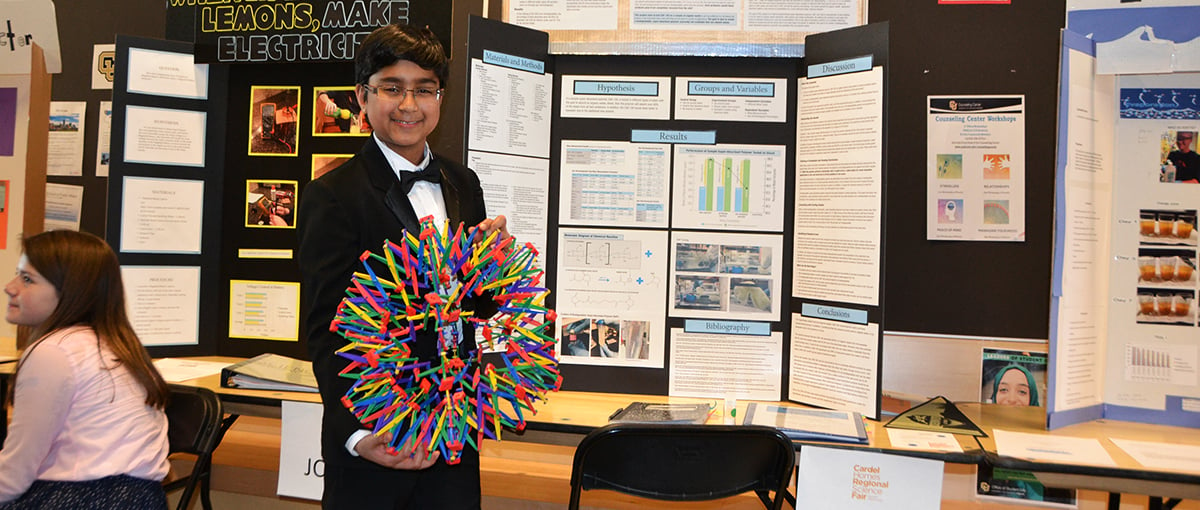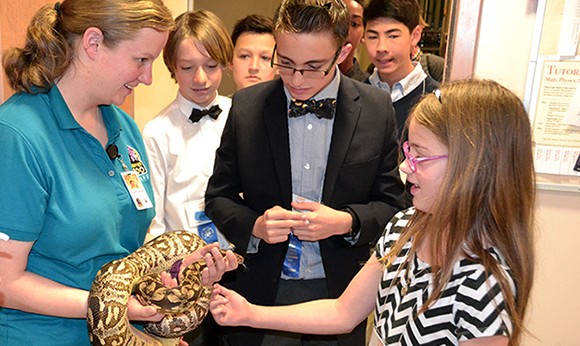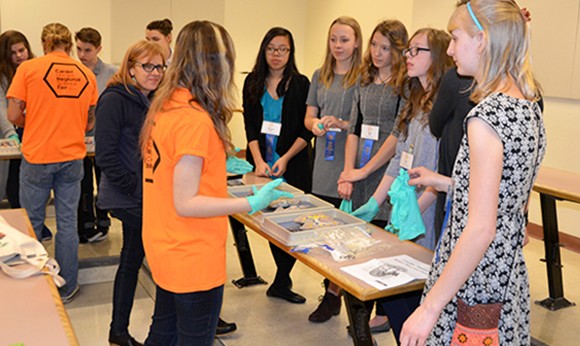Emhyr Subramanian, an eighth-grader at Challenge Middle School, wants to find a way to clean polluted water. He won’t be satisfied with solving the issue of oil spills in the ocean. He wants to clean up organic waste spilled in any body of water, large or small. He decided this problem would be the perfect topic for his project in the Cardel Homes Regional Science Fair (CHRSF)-Denver metro area, hosted on the CU Denver campus, with judges from both CU Denver and CU Anschutz.
 Emhyr Subramanian, an eighth-grader at Challenge Middle School, won Best in Show for his project, Chitosanic Change.
Emhyr Subramanian, an eighth-grader at Challenge Middle School, won Best in Show for his project, Chitosanic Change.
“Over the summer I was reading about all of the problems with waste,” Subramanian said. “I wanted to broaden my focus not just on oil, but any sort of organic waste, and not just in the sea, but also in lakes, rivers and even on land. That’s how I came across super-absorbent polymers (SAP).”
 Sophia Callender, a seventh-grader at Stanley British Primary School, tracked evaporation in five vessels over 48 hours to see how exposed surface area affected evaporation. She found that increased surface area increases evaporation, proving her hypothesis.
Sophia Callender, a seventh-grader at Stanley British Primary School, tracked evaporation in five vessels over 48 hours to see how exposed surface area affected evaporation. She found that increased surface area increases evaporation, proving her hypothesis.
Subramanian wanted to make sure that SAPs could be used to remove organic waste in water in an environmentally friendly and effective manner. He watched a 35-video course to learn the basics of organic chemistry and interviewed researchers in the field. Not only did he test a variety of SAPs to measure their effectiveness, he even developed his own SAP, which is biodegradable and does not leave residue. Subramanian’s project won Best in Show for the junior division.
A gateway to science
More than 460 middle and high school students from the Denver metro area showed off their ideas and experiments at the CHRSF. CU Denver and CU Anschutz faculty as well as outside professionals served as expert judges for high school and middle school projects, covering topics from technology to environmental issues.
Jennifer Hellier, director of the CHRSF, assistant professor in Family Medicine and Cell and Developmental Biology at CU Anschutz, and associate director of pre-professional education at the Colorado Area Health Education Program Office, knows that the fair is more than one day of projects. It can be the gateway to a career in the STEM fields. In fact, Hellier attributes her own career in sciences to her participation in the science fair during seventh and eighth grade.
“I have a passion for the science fair because it’s a great place for students to start their scientific inquiries and interest in science,” Hellier said.
Hellier has continued to watch student projects grow more complex and ambitious. She has been seeing students taking on more projects in energy, engineering and plant biology. One of the most memorable projects for her was a student who grew a fuel cell right under her bed.
For Hellier, nurturing interests in STEM topics is important for students and for Colorado.
“CU Denver and CU Anschutz are focused on making Colorado one of the best states for science and engineering,” Hellier said. “This science fair is our opportunity to highlight what is available at our campuses and also encourage students to continue on through STEM.”
Students get hands-on with science
 Students got hand-on with a boa constrictor from Madagascar brought in from the Denver Zoo.
Students got hand-on with a boa constrictor from Madagascar brought in from the Denver Zoo.
While the afternoon was spent showing off their own experiments and research, the morning was spent with hands-on activities such as using DNA “scissors” to cut DNA, touching a live boa constrictor from Madagascar and watching the dissection of cow eyeballs, pig kidneys and sheep brains with the CU Denver Biology Club.
Michael Ferrara, associate professor in the Department of Mathematical and Statistical Sciences at CU Denver, coordinated the hands-on activities for the fair. He rallied volunteers from CU Denver and CU Anschutz and the community to not only engage students, but also to give them a taste of some of the opportunities offered at CU Denver.
“This is a great opportunity to show them some things they haven’t seen and get them to think about some things they haven’t thought about,” said Ferrara. “This is also a tremendous opportunity for CU Denver. We had 460 brilliant kids here. Wouldn’t it be great if they had a really positive STEM-infused experience right here?”
Sharing their passions for science and math with middle and high school students was also an opportunity for student volunteers from CU Denver, as communication in STEM disciplines is becoming increasingly necessary.
 Students from the CU Denver Biology Club dissected dissection of cow eyeballs, pig kidneys and sheep brains in a hands-on session.
Students from the CU Denver Biology Club dissected dissection of cow eyeballs, pig kidneys and sheep brains in a hands-on session.
“One of the big barriers we face as scientists is the ability to communicate science to the general public,” Ferrara said. “Talking to a middle schooler really makes you think about the best way to explain your science.”
